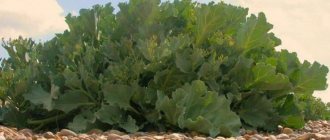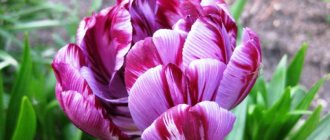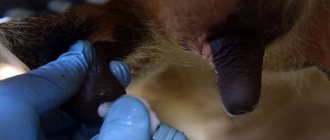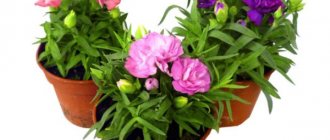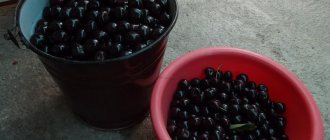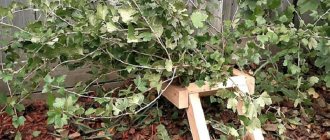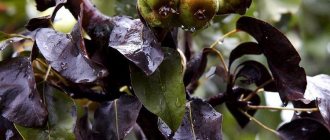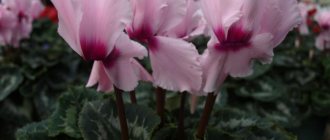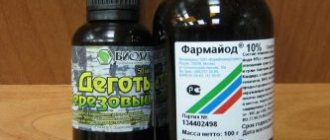Proper care of cherries includes not only watering, pruning and loosening the soil. It is also important to protect plants from diseases that could leave you without a harvest. Let's figure out how to protect cherries from major ailments.
The list of all possible diseases of cherries is quite large. We will tell you how to recognize and overcome them.
Cherry diseases
All cherry diseases are divided according to distribution:
- Fungal, forming spots, dying of leaves, berries, trunks. This is the most common type of disease. They spread by spores and are carried by dirty tools and wind.
- Bacterial - microbial infection, insect pests, wind, dirty tools.
- Viral - introduced by insects and transferred from one area to another. There are no drugs for viral diseases; they manifest the vascular system. Only removing a diseased tree can save the garden.
- Non-infectious - improper care, frost damage, pruning at the wrong time and incorrectly, sealing raw cuts with wax, breaking branches under snow or fruit load.
Latest articles about gardening
Salting cabbage in February 2021 according to the lunar calendar
How to treat pepper seeds with hydrogen peroxide before planting seedlings?
Treating pepper seeds with potassium permanganate before planting seedlings
Preventative measures, ridding the garden of pests and careful attention to each damaged leaf will help keep the cherry tree healthy.
Gommoz
Gommosis, or gum bleeding, is observed not only in cherries, but also in all stone fruit trees. On trunks and branches, even on fruits and foliage, there are often streaks of a thick viscous substance similar to resin - gum.
gum deposition of cherries - in the photo
Excessive production of gum indicates a problem with the plant. The reasons may be different: wounds, frost damage, excess nitrogen fertilizers, fungal diseases and pests, treatment with growth regulators and phytohormones. Therefore, it is necessary to find out what caused the excess secretion of gum.
How to fight? The wood in the place where the gum is released must be cut away to a healthy layer, and then the wound must be treated with copper sulfate and covered with garden varnish.
Prevention of cherry clasterosporiosis
Promptly remove and burn all dry and damaged branches and leaves. Regularly dig up the soil in the tree trunk circle.
The causative agent of the disease persists in cracks in the bark and tissues of the shoots, so heal all wounds on the trees. First, clean them well, then disinfect them with a 1% solution of copper sulfate and coat them with garden varnish.
In early spring (before the buds open), spray the crown of trees and the soil in the tree trunks with nitrafen or 1% copper sulfate.
Control measures
In the green cone phase (at the beginning of bud break), spray the plants with Bordeaux mixture (100 g per 10 liters of water). After flowering, repeat the procedure. 15-20 days after the end of flowering, carry out the third treatment, and no later than 20 days before harvesting, carry out the fourth.
How to treat cherries against other caterpillars
The following is information about other types of pests in whose development cycle a caterpillar is present. You can find out how to treat cherries against caterpillars after describing a particular type of pest.
The birch moth Amphidasis betularia L. is a butterfly with a wingspan of 40-50 mm. The wings are light gray with many black dots of varying sizes and wavy transverse stripes on the front and hind wings. The body is thick, cone-shaped. The length of the caterpillar is 50 mm, the color ranges from dark green with a red stripe on the back to brownish-brown with a dark stripe on the back. There are two protrusions on the head, and white warts are visible on the eighth and eleventh abdominal segments. The caterpillars of all other moths have only two pairs of abdominal legs, which is why they bend twice when moving. The pupa is shiny, dark brown in color.
Butterflies fly in May-June; females lay 600-2000 eggs, placing them in groups in crevices in the bark. After some time, the caterpillars hatch and feed from late June until autumn, gnawing on tree leaves. Having finished feeding, the caterpillars pupate in the soil, and the pupae overwinter until next year. The birch moth is widespread and causes great damage to deciduous trees, fruit and berry crops, especially in young gardens.
Control measures. Preventive spraying of gardens in the spring, when buds open and immediately after flowering, with fufanon or its analogues (kemifos, karbofos) also reduces the number of moths. If there are a large number of caterpillars in the summer, spraying with the same preparations is carried out, taking into account the waiting period. Fitoverm, Kinmiks, Actellik, Inta-Vir are also used.
The smoky ash moth Boarmia consortaria F. is a butterfly with a wingspan of 43-50 mm. The wings are ash-gray, covered with dark brown pollen, the edge of the hind wings is wavy. The middle field is not prominent, the outer line is noticeable only on the veins. The caterpillar is gray, with brown spots, warts and a dark stripe on the back. The pupa is brown in color, in an earthen cocoon. The pupae overwinter in the soil, butterflies emerge in May, and two generations develop over the summer. The flight of butterflies of the first generation is observed in May, and of the second - in August. Caterpillars feed on leaves, roughly eating the leaf blades. The moth damages all stone and pome crops, as well as deciduous trees.
Control measures are the same as against the birch moth.
The winter moth Operophthera brumata L. is a butterfly with a male wingspan of 28-30 mm. The front wings are gray with dark transverse wavy lines, the hind wings are ash-gray. The female is brownish-gray, 10-12 mm long, with underdeveloped wings, inactive, climbs trees along the trunk. The eggs range from yellow-orange to brick-red and brown. The caterpillar is 20-25 mm long, has 5 pairs of legs, yellowish-green with a brown stripe on the back and three light stripes on the sides, the head is yellow-brown. The pupa is light brown and has a forked spine at the end. The eggs overwinter on branches, at the base of the buds.
When the buds open, caterpillars hatch and feed on buds, flowers, ovaries and leaves, entwining them with cobwebs. Often the caterpillars feed between two webbed leaves. Having finished feeding, the caterpillars descend to the ground and pupate in the soil at a depth of 5-10 cm in an earthen capsule. In October, butterflies emerge, males fly until late autumn, females climb trees and lay eggs one at a time or in groups after fertilization. The fertility of one female is 200-350 eggs. The moth damages all fruit crops and deciduous trees.
Control measures. Spraying in the spring, when buds open and immediately after flowering, with fufanon or its analogues (kemifos, karbofos). In the fall, it is recommended to apply trapping glue belts to the trunks to catch butterflies, mainly female moths, which do not fly.
Moon moth or smoky moth Boarmia selenaria Schiff. , is a butterfly with a wingspan of 38-46 mm, grayish-white in color with numerous black and brown dots on all wings. On the front wings there are two black zigzag transverse lines and a large spot with a dark rim. The hind wings have one transverse sinuous line and a round spot in the middle. In a calm state, the butterfly folds its wings into a triangle and puts out its front legs in the form of antennae. The caterpillar is up to 50 mm long and 3-4 mm wide, thin, gray-green, often red or dark brown with a dark spot on the back. Two generations develop.
Pupae overwinter in the soil, butterflies emerge in the spring, feed on nectar and are nocturnal. Females lay eggs on the leaves of herbaceous and woody plants. The caterpillars skeletonize and gnaw off the leaf blades, leaving only the central veins at the end of feeding. Caterpillars of the first generation cause damage in May-June, the second - in August-September. The moth damages all pome and stone fruit crops, severely harms black currants, and among herbaceous crops - wormwood, sweet clover, etc.
Control measures. If the number of caterpillars is large, trees are sprayed with fufanon or its analogues (kemifos, karbofos), taking into account the waiting period. Preventative spraying of trees in the spring, immediately after fruit blossoms, with the same drugs against a complex of pests also reduces the number of moth caterpillars.
Vannessa polychloros L. - a large brick-red butterfly with black spots on the wings. The wingspan is 50-55 mm, on the underside they are dark brown and have a characteristic white dot. The eggs are brown, ribbed, the caterpillars are 45 mm long, bluish-black, with a black head, covered with fully branched yellow spines. There is a rusty-brown longitudinal stripe along the back and two similar stripes on the sides of the body. The pupa is angular, 25 mm long, yellowish-gray, with two spines on the head and pearlescent spots on the back. Butterflies hibernate. In the spring, the female lays eggs on the branches in a continuous layer; each oviposition can contain from 50 to 150 eggs. After 15-16 days, caterpillars hatch and live in broods, completely eating the leaves.
Polyflower is found everywhere and greatly harms stone fruits, pears, and some deciduous trees, such as elm.
Control measures. Preventive spraying of trees in the spring, when the leaves bloom and immediately after flowering, with the drug fufanon or its analogues (kemifos, karbofos) also reduces the number of multiflower caterpillars. If there are a large number of caterpillars in the summer, spraying with the same preparations is carried out, taking into account the waiting period. Fitoverm, Kinmiks, Actellik, Inta-Vir are also used.
- Author: admin
Rate this article:
- 5
- 4
- 3
- 2
- 1
(10 votes, average: 5 out of 5)
Share with your friends!
Cherry pests and their control
- Cherry fly. This is the most common and dangerous pest for cherries. The cherry fly lays eggs in unripe fruits, where the larva then eats the pulp. Control cherry flies with insecticides.
- Cherry shoot moth. This insect destroys cherry buds, leaves and flowers. Moths are destroyed at the stage of bud swelling with the help of the drugs “Holon”, “Chlorofos”, “Karbofos”.
- Cherry sawfly. This insect makes entire web nests on trees. Sawfly larvae eat the pulp of the berries. Treatment is carried out with the same drugs as when fighting shoot moths.
It is noteworthy that cherries are susceptible to the same diseases and pests as cherries and plums. Therefore, having studied control methods using the example of cherries, you can care for a rich and fruitful garden.
Signs of the disease
All diseases are characterized by certain symptoms. Each disease has its own distinctive characteristics. In order to correctly diagnose and prescribe treatment for cherries, you need to know the main signs of disease. These include:
- the appearance of red dots on the foliage;
- observation of gray or brown growths on the stem;
- the formation of a gray or white dense coating on the berries;
- yellowing and falling leaves;
- formation of red cone-shaped growths;
- fruit rot on the branch;
- root rotting;
- holes on leaves;
- the presence of black specks or holes on the shoots;
- drying out of foliage at the ends of branches in the middle of the season;
- crop dumping;
- flow of gum from the trunk in autumn.
